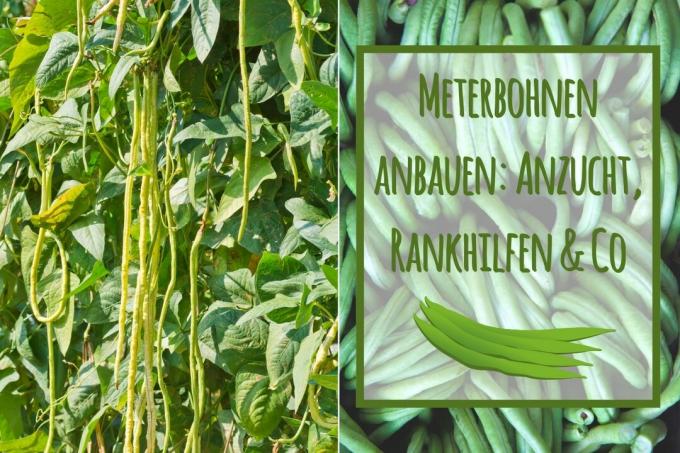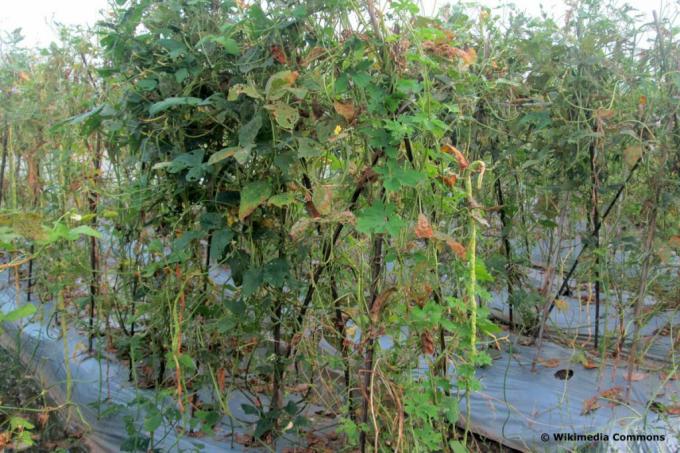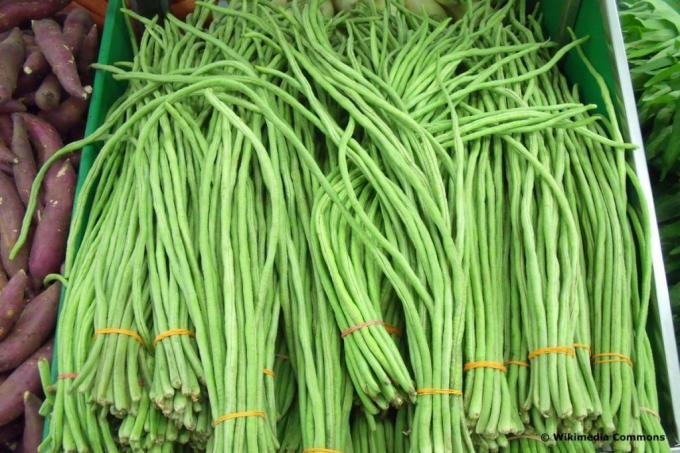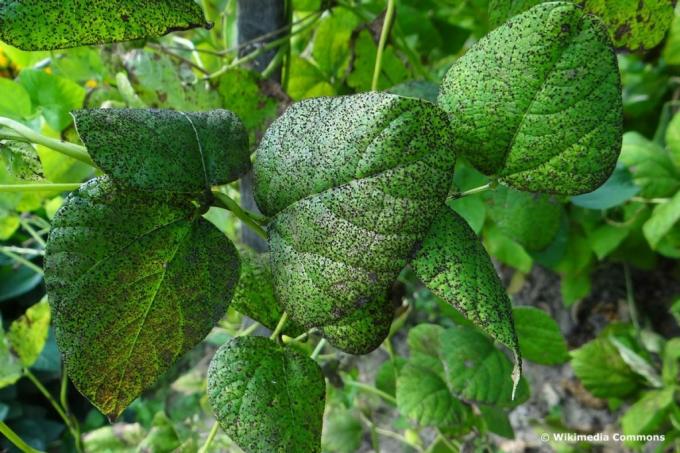
table of contents
- The yard bean
- Location
- Cultivation
- Cultivation in the greenhouse
- Height
- Climbing aids
- care
- To harvest
- Pests
- Diseases
- Mixed culture
- Crop rotation
- frequently asked Questions
The yard bean doesn't get its name for nothing. The pods are a lot longer than the usual runner beans. They are best grown in warm areas. You can find out everything you need to know about culture here.
In a nutshell
- the name and its synonyms come from the length of the beans
- the original home is warmer, so there is less yield here in the field
- the asparagus bean is planted like the common kidney bean
- In contrast to other beans, snake beans can be eaten raw
The yard bean
The yard bean (Vigna unguiculata subsp. sesquipedalis) belongs to the butterfly group and is native to Africa and Asia. It is annual and has only a short cultivation period. For a consistently high yield, it needs uniform warmth throughout the day and night, which we cannot guarantee. Growing in a greenhouse is possible, but because of the risk of spider mites, it is more time-consuming than growing outdoors.

Other features:
- needs warmth, ceases to grow below 20 degrees
- depending on the variety, climbing or bush-shaped
- Cultivation time about 12 weeks
- attractive flowers in white, light yellow or purple
- Pods between 30 and 50 cm long
- tolerates drought
Location
The snake bean likes it warm, sunny and protected. A little shade at the location is not a problem, but it does not grow well in full shade. The floor does not need to have any special properties. Normal garden soil is sufficient as long as it is loose and deep. Dry soil is preferable to waterlogging. Yard beans grow better in sand than in clay soils. It is important to have a place sheltered from the wind so that the shoots and tendrils do not kink. Nevertheless, enough air should get to the plants so that they dry off quickly after rain.
Cultivation
There are two options for growing yard beans:
- Prefer in the greenhouse, cold frame or on the windowsill
- No-till in the open
Prefer
Growing them in a warm place can give the beans a head start in growth. However, this only works if the nights after planting are not too cool.
Planting out is easier later if a single pot is used for each bean plant. This can then also be smaller. Otherwise a pot with a diameter of 10 cm is used for about 4 to 5 plants.
Instructions:
- Start sowing at the end of April
- Fill the pots with garden soil up to 3 cm below the rim
- distribute the seeds and then fill in the soil
- water well
- Germination temperature evenly at 20 degrees
- when the plants have grown vigorously, transplant in mid-May
Growing outdoors
One advantage of growing outdoors is that later transplanting is not necessary. In addition, no additional space in the warm is required. Meter beans can be sown in the eyrie or in rows.
Instructions:
- sow from May to mid-July at the latest
- When sowing rows in rows, plant a bean every 5 to 10 cm at a distance of 40 to 50 cm
- When sowing clumps, fold 3 beans every 40 cm
- a sowing depth of 3 cm applies to both variants
- Cover the seeds with soil and press down a little
- water well
- Germination time about a week, longer in cool weather, keep it moist

Cultivation in the greenhouse
Higher yields of the meter beans are obtained in the greenhouse, as the temperatures can be kept warm evenly throughout the day and night. The care is similar to the culture in the field. The beans are sown as soon as it is warm enough in the greenhouse and kept moist until they emerge. Later, the plants are watered only when necessary. In the greenhouse, the plants are best climbed on strings. While the bean fly under glass is a rare pest, spider mites and white flies can become a nuisance. Good ventilation and high humidity is very important.
Height
Climbing yard beans can reach heights of 2 to 3 m. So you need a climbing aid that is high enough. Alternatively, they can also grow on a fence or wall, provided the fence or wall corresponds to their height. Wire or a taut rope is sufficient for guiding.
Climbing aids
All trellises that are correspondingly high are suitable. They don't necessarily have to be bought. Old tool stems or branches of trees can also be used as climbing aids. The climbing aid is attached when the beans have grown 15 cm high.
Note: The beans are piled up for better stability.
care
The yard beans are easy to care for. At the beginning, the shoots may have to be routed to the climbing aids and tied. Later the plant climbs up on its own. The soil should be chopped every now and then. Existing weeds are removed. A mulch cover not only protects against weeds, it also keeps the soil loose and moist.
water
Asparagus beans need sufficient water, especially at the beginning. When the upper soil layer has dried, the plants are watered. Later, care should be taken to ensure that the entire plant does not get wet when watering. It is enough if the root area remains moist. If the asparagus beans are too dry, the pods become fibrous and hard. Waterlogging causes the roots to rot. Good soil aeration helps with nitrogen formation.
fertilizer
Like other butterflies, snake beans have nodule bacteria on their roots that bind nitrogen from the air. An additional nitrogen-based fertilizer is therefore not necessary. At most, a little rock flour can be helpful to enrich the soil with minerals.
To harvest
Asparagus beans form long pods that are very tasty even when they are young. The beans are harvested as long as the seeds have not yet fully developed, this can be recognized by the small bulges on the pods. If the beans are continually harvested, they always form new flowers and pods. You cannot keep beans fresh for long. They keep in the refrigerator for about 2 days. However, they taste best right after harvesting. Snake beans are easy to freeze, boil down or dry.

Pests
Snails
Snails occur especially in very young plants and can cause great damage. With a few young bean plants, however, it is sufficient to protect them with a snail collar. However, a snail fence protects the entire bed from snails and is easy to attach. However, care must be taken that no other plants that are too large will create a transition anywhere around the bed. The planting around the bean patch must therefore be kept as short as possible.
Black bean aphid
Another pest is the bean aphid, which gathers on the shoots and sucks plant sap there. A strong bean can handle a few aphids without being damaged, but if the pests get out of hand, shoots or leaves cripple. Heavily infested shoots can be cut from the plant along with the lice.
Bean fly
The bean fly is so dangerous because it attacks the seedling, sometimes even the seeds. The maggots drill holes in the seed and eat it from the inside. The plants either do not germinate at all or only very slowly. Most of the time, the seedling dies immediately after emergence. Late sowing is helpful against the bean fly because, on the one hand, it does not like high temperatures and, on the other hand, the beans germinate more quickly. In addition, cultivation under glass protects against the bean fly.
Diseases
Bean grate
Fungal diseases can attack the beans in damp weather. Bean rust first shows up as white, later brown pustules. They appear on leaves and stems. It doesn't help to just cut off the infected parts of the plant. It is better if the entire bean is removed. It must not be put on the compost, it belongs in the organic or household waste.

Gray mold
Gray mold is less dangerous than bean rust, although it can attack very young plants if they are kept too moist. The fungus shows itself through whitish to greyish spots and a furry fungal lawn on leaves or stems. The infected parts can be cut off. The plant should be cultivated more dry overall.
Mixed culture
The asparagus bean grows well with cucumbers, cabbage, strawberries, beetroot, potatoes or tomatoes. However, care must be taken that they do not overshadow other cultures. However, other legumes, such as peas or leek vegetables, are less suitable for cultivation in mixed cultures.
Note: A mixed culture with savory should also help against pests.
Crop rotation
Meter beans are poor eaters. In the crop rotation, they are cultivated according to medium-size eaters. This is followed by either a green manure or heavy consumption, which is also supplied with manure or compost. The same applies to beans in mixed cultivation with other weak eaters. In the case of other planting partners, however, you also have to pay attention to their properties.
Note: No other peoples are grown on the bed before and after beans. Beans should only be placed on the same bed again after 4 years.
frequently asked Questions
Unlike many other beans, the snake bean can be eaten raw. Leaves and shoots are also edible, for example in lettuce. As with other vegetables, the asparagus bean can be boiled or fried in the pan.
Before resorting to chemical solutions, biological or home remedies should be tried first. Water or spider mites often help against lice and spider mites. an increase in humidity. Other animal pests are eaten by beneficial insects.
As long as it is a non-seeded variety, this is possible. Hybrid varieties are not suitable for further propagation because the properties of the daughter plants cannot be foreseen. The seeds should mature on the plant and are then kept dry.
It is not necessary to cut the shoots. At most, they can be shortened a little if they grow beyond the trellis.
